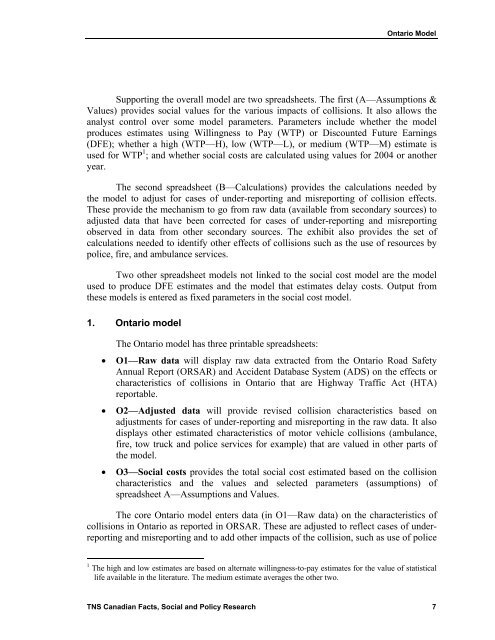Keith Vodden Dr. Douglas Smith - Transports Canada
Keith Vodden Dr. Douglas Smith - Transports Canada
Keith Vodden Dr. Douglas Smith - Transports Canada
You also want an ePaper? Increase the reach of your titles
YUMPU automatically turns print PDFs into web optimized ePapers that Google loves.
Ontario Model<br />
Supporting the overall model are two spreadsheets. The first (A—Assumptions &<br />
Values) provides social values for the various impacts of collisions. It also allows the<br />
analyst control over some model parameters. Parameters include whether the model<br />
produces estimates using Willingness to Pay (WTP) or Discounted Future Earnings<br />
(DFE); whether a high (WTP—H), low (WTP—L), or medium (WTP—M) estimate is<br />
used for WTP 1 ; and whether social costs are calculated using values for 2004 or another<br />
year.<br />
The second spreadsheet (B—Calculations) provides the calculations needed by<br />
the model to adjust for cases of under-reporting and misreporting of collision effects.<br />
These provide the mechanism to go from raw data (available from secondary sources) to<br />
adjusted data that have been corrected for cases of under-reporting and misreporting<br />
observed in data from other secondary sources. The exhibit also provides the set of<br />
calculations needed to identify other effects of collisions such as the use of resources by<br />
police, fire, and ambulance services.<br />
Two other spreadsheet models not linked to the social cost model are the model<br />
used to produce DFE estimates and the model that estimates delay costs. Output from<br />
these models is entered as fixed parameters in the social cost model.<br />
1. Ontario model<br />
The Ontario model has three printable spreadsheets:<br />
• O1—Raw data will display raw data extracted from the Ontario Road Safety<br />
Annual Report (ORSAR) and Accident Database System (ADS) on the effects or<br />
characteristics of collisions in Ontario that are Highway Traffic Act (HTA)<br />
reportable.<br />
• O2—Adjusted data will provide revised collision characteristics based on<br />
adjustments for cases of under-reporting and misreporting in the raw data. It also<br />
displays other estimated characteristics of motor vehicle collisions (ambulance,<br />
fire, tow truck and police services for example) that are valued in other parts of<br />
the model.<br />
• O3—Social costs provides the total social cost estimated based on the collision<br />
characteristics and the values and selected parameters (assumptions) of<br />
spreadsheet A—Assumptions and Values.<br />
The core Ontario model enters data (in O1—Raw data) on the characteristics of<br />
collisions in Ontario as reported in ORSAR. These are adjusted to reflect cases of underreporting<br />
and misreporting and to add other impacts of the collision, such as use of police<br />
1 The high and low estimates are based on alternate willingness-to-pay estimates for the value of statistical<br />
life available in the literature. The medium estimate averages the other two.<br />
TNS Canadian Facts, Social and Policy Research 7
















